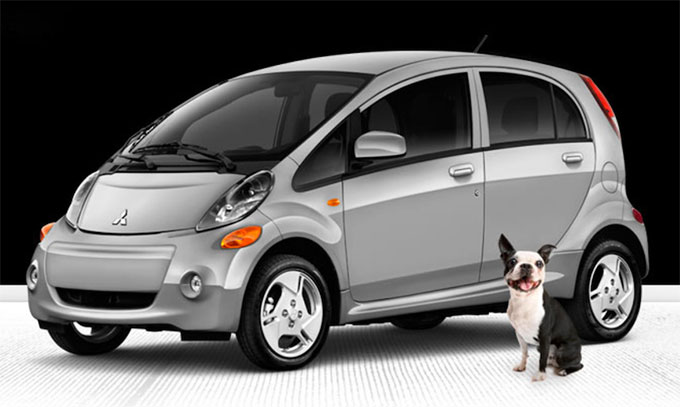Plug 'n' Go
by Jim Corbran

The 2012 Mitsubishi i-MiEV
You’re forgiven if you’ve never before seen one of these. Its full (and rather cumbersome) name is Mitsubishi i-MiEV—the MiEV part standing for “Mitsubishi innovative Electric Vehicle.” I don’t know who their capitalization consultant was, but I suspect it was someone who thought a random mix of upper- and lower-case letters was “hip.” To me it’s just confusing.
You may have noticed at the top of the page that this is a 2012 model, and that’s because Mitsubishi hasn’t yet started producing any 2013 i-MiEVs.
For brevity’s sake, we’ll refer to this week’s test car as the i-car. I picked up the two-toned blue-and-white sedan at Transitowne Mitsubishi in Williamsville, where sales guy Paul Jones briefed me on the car, an all-electric plug-in vehicle with no internal combustion engine. Power comes from a 49-kilowatt electric motor producing 66 horsepower, which is connected to a single fixed-speed transmission. Step on the accelerator (it’s not a gas pedal if it doesn’t use gas) and you go. Right away. No momentary hesitation as the engine and transmission communicate; as with most things electric, it’s either on or off. This being a small car means that 66 horsepower is most of what you need.
Styling of the i-car is polarizing. Some will appreciate the modern lines as maybe being what the Jetsons drove just before flying cars finally hit the showroom. Others will be put off, especially by the very short front overhang which doesn’t seem to leave much between you and whatever’s right in front of you. But there’s plenty of room inside for you and three other folks. Head and leg room is generous for everyone, and there’s a bit of a storage compartment behind the rear seat. The ride itself seemed like that of any small car.
Driving the i-car however, does have its differences. First off, I have to mention that I was distracted the whole time by the shape of the windshield and the position of the wipers. I imagine that after a time you get used to it.
Putting the gear selector in drive sets you up for your ride in one of three selectable driving modes:
■ “D,” which is the standard mode you’ll use under most driving conditions. It’ll give you 100 percent of the available torque as soon as you press the accelerator. Not great for maximizing your drive time, as it uses up the charge quicker;
■ Then there’s “Eco,” which, you can probably figure out, economizes your power usage, meaning a slower response time but a longer range—best for in-town stop-and-go driving where acceleration isn’t an issue;
■ And finally there’s a “B” mode, which Mitsubishi describes as “the strongest calibration of regenerative braking capability…best for traveling down hill.”
I’ll have to say that the Eco mode was a letdown around suburbia. It’s definitely something better left for city driving. The D mode was fine, however. Seeing that that aren’t a lot of hills in northern Erie County, I didn’t get to try out the B mode.
Overall impression? The i-car would make a great commuter car. With a driving range of up to 74 miles in city driving with the a/c and heat turned off, it would ideal for a city-dweller with a city job. Of course, so would a Metro bus. Turn on the heat in your i-car and that range drops to 49 miles (or 62 with just the a/c), so maybe it’s better-suited as a warm-weather car. At $21,625 (after the federal tax credit) it might sound steep—until you compare the cost of gas to the cost of a recharge.
Like it or not, should you live long enough, this is your future, Mr. and Mrs. Driver. I think it’s shaping up okay.
More info at www.mitsubishicars.com.
Read more of Jim Corbran's You Auto Know every other week in Artvoice, and more frequently on Artvoice Daily.
blog comments powered by Disqus|
Issue Navigation> Issue Index > v12n4 (Week of Thursday, January 24) > Plug 'n' Go This Week's Issue • Artvoice Daily • Artvoice TV • Events Calendar • Classifieds |









 Current Issue
Current Issue